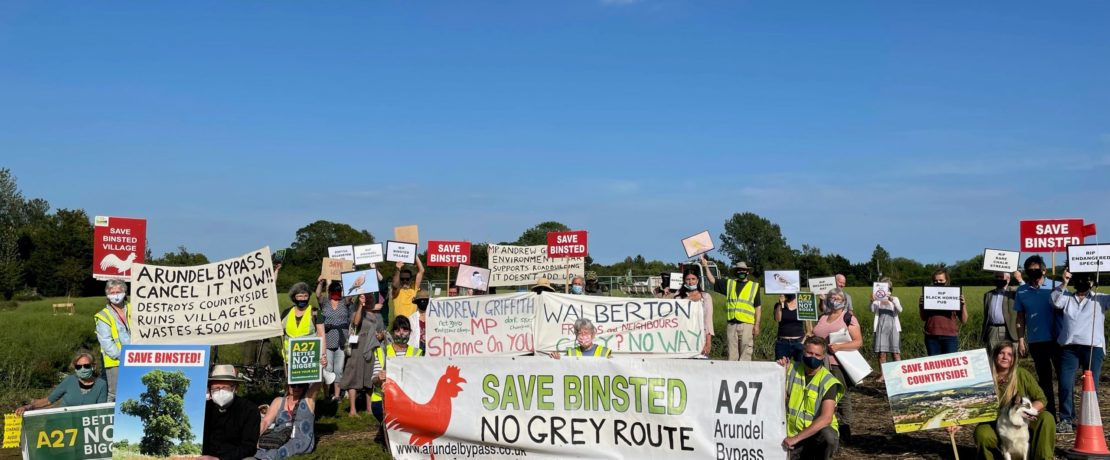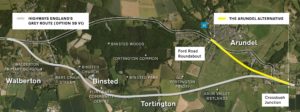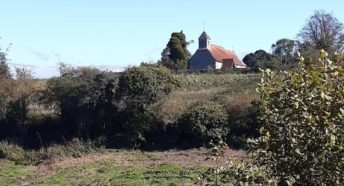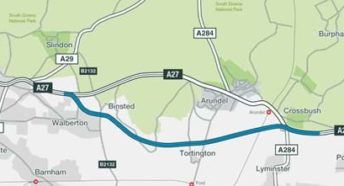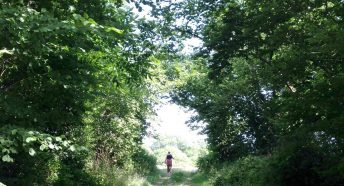Arundel Bypass protests continue
Residents from Arundel and villages threatened by the proposed 8 km Arundel Bypass gathered last week to highlight how the road would blight their historic and wildlife-rich landscape.
People came together to protest against the bypass, at the point where the road would sever the village of Binsted and under one of two proposed seven metre high bridges next to people’s homes.
The proposed bypass is raised on banks or a viaduct as it crosses the Arundel watermeadows south of Arundel, spoiling the view of the town and dissecting Tortington. As it passes through Binsted it is at ground level, but at the Binsted Rife Valley it is on a viaduct across the valley. It then enters a cutting to pass through north Walberton, near a primary school, cutting the edge off the half-built housing development of Avisford Grange.
The road would pass on a raised viaduct 10m from the churchyard wall of the ancient listed church of St Mary’s, Binsted, ending nearly a thousand years of peaceful community life. Light pollution would mean loss of the churchyard for star-gazing. As well as damaging villages and destroying the natural habitat between the Arun water meadows and Fontwell, the road will increase carbon emissions.
Unusually, Highways England has already appointed contractors for the scheme. Campaigners believe this haste reflects the agency’s fear that the climate and ecological emergency means time must soon be called on this type of scheme. The protestors emphasised that Highways England does not have permission to start building the controversial new road across the Arun Valley – and may well never get it.
Simon Rose of Arundel SCATE explained: ‘Some people see Highways England’s compounds and machinery on sites across the area and assume that construction work is starting. In fact, it is only at the start of the process to gain approval and hasn’t even held statutory consultation yet, let alone the stages that have to be completed before getting permission. Highways England should be clear that there is a long road ahead and they shouldn’t jump the starting gun as it may never be fired.’
Highways England is currently conducting exploratory drilling to check geological and other aspects along the proposed route. This involves boreholes up to 30m deep. Local people along the route have complained about the loud voice from robots in fenced areas, shocking passers-by on a public path, or set off when a vehicle drives by.
In 2019, two-thirds of the people who responded to Highway England’s last consultation rejected the big offline road options offered. Nearly half of them called for the Arundel Alternative, the community-led, low impact proposal which would meet traffic needs. The agency ignored community views and is pursuing the largest, most expensive and hugely damaging offline ‘Grey’ route.
Public consultation on the Bypass, which would cost at least £500m, will start later this year. Residents plan bigger protests after Covid-restrictions are eased.
This article is drawn from SCATE’s press release of 24 June. CPRE Sussex is a member of the South Coast Alliance for Transport and the Environment (SCATE).
Local campaigns against the bypass: www.arundelbypass.co.uk, www.a27arundel.org and www.arundelalternative.org.
See Map of proposed Grey route:
